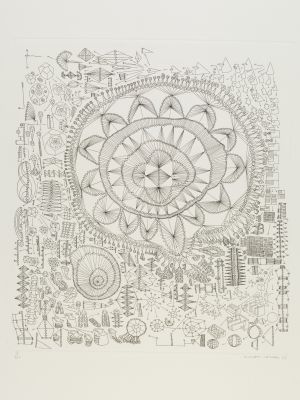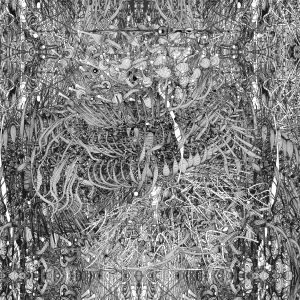This is another rare FormSynth etching from William’s time as a “Henry Moore Scholar” at the Royal College of Art, when he was heavily influenced by the time he spent at the Natural History Museum observing museum exhibits of natural forms and reading about Darwinian evolution. It shows the evolution of a cone that is subjected to a number of incremental rule-based "shape changing" steps using simple sculptural modifications designed by William known as "Beak", "Bulge", "Scoop" and "Stretch" and other rules. These individual rules harnessed the conceptual idea of a single sculptural action being performed on an imaginary form by the artist such as “taking a scoop out of the form” or “squeezing the form so it bulged out at a particular point”. For example, with the Beak operator the artist imagines a beak-like form being pinched and pulled from the form (which might be, for example, on a cone or another evolved form). The effect of this single action is imagined by the artist and then drawn by the artist adjacent to the ‘parent’ form and then connected by a single arrow showing it’s evolutionary path and so on. The number and order of sculptural modifications could be in many 100s, in effect using the artist’s own mind as a 3D drawing device, so to speak.
In the FormSynth drawings, even though the individual sculptural operators are quite simple, when used cumulatively in different ordering, visually rich and varied forms emerge as new generations are spawned. This etching shows an evolutionary tree of forms derived from a cone with one major "black crystal" mutation, showing multiple simultaneous evolutionary steps dominating the image. All of William’s work from this period reflects his fascination with evolutionary systems and the idea of a new alternative evolutionary system to nature driven by the artist. No traditional Western pictorial composition is used, with the process of evolutionary drawing only stopping only when there is no more space on the sheet to fill. The FormSynth drawings were to form a blueprint for the subsequent Mutator software Art, where the computer drives the evolution together in partnership with the” artist as Gardner”. Here with FormSynth created in a low tech art studio at the Royal College of Art, the artist must rely on their own resources and own drawing ability.





